27 October 307
Maxentius claims the rank of Augustus (at Rome).
27 October 312
A dream evokes Constantine to place a sign of Christ upon the shields of his soldiers before they enter battle (at Rome).
27 October 1778 Tuesday
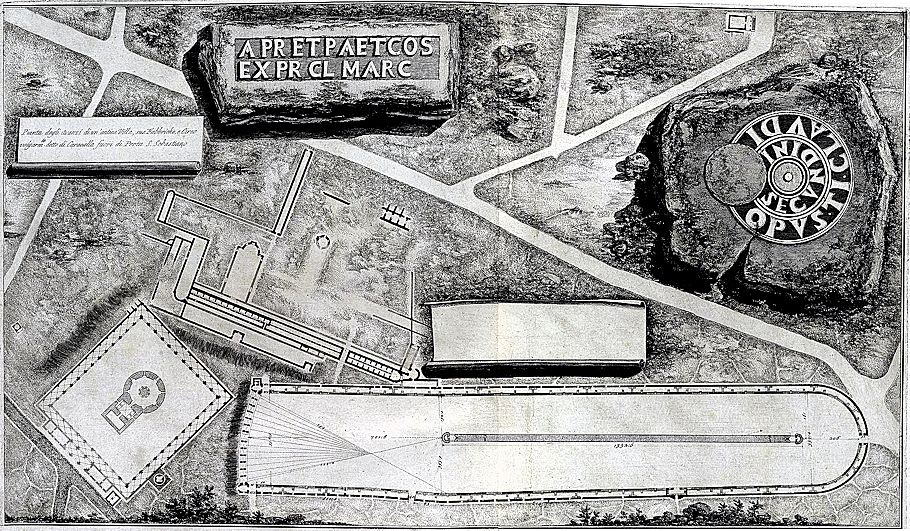
"I still think the circus on the Appian Way has nothing to do with Caracalla."
27 October 1812 Tuesday
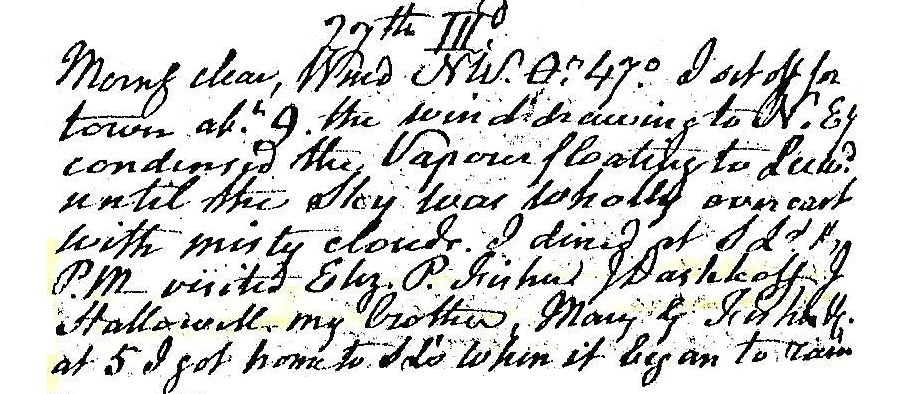
Morning clear, wind NW, temperature 47°. I set off for town about 9. The wind drawing to N easterly condensed the vapor floating to leeward until the sky was wholly overcast with misty clouds. I dined at SL's and PM visited Eliz. P. Fisher, J. Daschkoff, J. Hallowell, my brother, Mary G. Fisher, etc. At 5 I got home at SL's when it began to rain.
27 October 1994
121.
I can at this point only bring up the supposed importance of the diaphragm being connected to the rib cage. This is an operation of the diaphragm being dependent on a stable structure for it to function properly. The diaphragm needs support for it to relax and contract against. I'm still not sure of the real place of the diaphragm in the theory, but I am already thinking of the rib cage representing a much more structure/controlled phase of humanity. This actually is a bit scary to me because it brings to mind the idea of "Big Brother is watching"--George Orwell, 1984.
122.
The diaphragm is a fluctuating separation. As it separates it contracts and relaxes. In terms of time, it has an effect on both the time that comes before it and the time that comes after it. I think that even for a time, the plane of the present is slicing through the diaphragm with the stomach (etc.) on the inside and the lungs on the outside, all of which is encased within the rib cage. As time goes on, the lungs gradually take up more space and the digestive system takes up less, with the diaphragm always separating them. The diaphragm remains the ever effective mediator between the realm of metabolism and the realm of osmosis. The diaphragm is something like a two-way mirror--its movements create pressure which in turn facilitates both breathing and defecation--input vs. purge, it could be said.
123.
I think I have hit upon the real significance of the diaphragm. The diaphragm is the separation, transition, and driving force between metabolism and osmosis. The diaphragm plays an important part in the purging aspect of metabolism. When the plane of the present begins to slice through the diaphragm, this represents the beginning of the end of the purge within humanity. The essential difference between metabolism and osmosis is that osmosis does not have an aspect of purging.
I have to interject here because I just realized (as I was typing this note) that the lungs (i.e. osmosis) do in fact have an aspect of purging, namely the exhaling of carbon dioxide. This could imply that after the diaphragm the purge is upward and of a single element.
This is not the only difference though because metabolism is a working with and manipulation of material (received data) and osmosis is more of a co-mingling of material--a joining and a fusing--a synthesis through togetherness rather than creation through destructive manipulation.
125.
Now I will address the role that the diaphragm plays in birth. This, of course, relates to the whole idea of pregnancy and the fact that the plane of the present passes through the area of pregnancy between the years 770 A.D. and 3090 A.D. The diaphragm occurs in the human body--the Timepiece--at the same time that the pregnancy ends and the birth occurs. This birth then occurs and coincides with the transition from metabolism to osmosis. This birth also coincides with the end of the period of major purge in humanity. ...and now it is clear that the second birth coincides with the end of the epoch of purge.
27 October 1997
more Campo Marzio notes
I went through the xerox copy of the Campo Marzio text that Sue Dixon sent me, and I have come up with some further ideas/enlightenments. First of all, I found new significance in the Scenographia because if the ruins that Piranesi calls out in the aerial perspective are actual (i.e., hold veracity), then there is more evidence against the notion of absolute fabrication in terms of the reconstructed plan. The Scenograpia also depicts actual ruins collaged in the foreground and border, and I will further investigate this in terms of possibly providing more evidence toward sound archeology/reconstruction.
Within the original text there is also a list of existing ruins from the site either in situ or in fragments. Again, this list offers the best possible source for veracity when it comes to establishing which buildings actually once existed vs. which were fabricated by Piranesi himself. I will use this list as part of the information that is presently available for each building. Furthermore, there is a "catalogo" which lists all the literary references available for the buildings that once existed within the Campo Marzio. I think it would be a wonderful project to collect the actual texts pertaining to each building, and then offer the text in conjunction with the plan of the building. This will greatly enhance the illustrated glossary, in fact, the final documents will be more like a Campo Marzio encyclopedia. I am going to start by translating (more like transcribing) the list, and at least apply that data to a web page for each list. The good thing about Piranesi's list is that it also gives me a ready made building list that I can already turn into a web page.
In addition to Piranesi's text, I have also done some recent reading from Krautheimer's Rome: Profile of a City, 312-1302. The first chapter in part I is pretty much the only material that relates to my Campo Marzio research, because it gives a fairly clear picture of the role of Constantine in the first Christian building projects of Rome. I am trying to determine the date in time that the Ichnographia represents. Right now the oldest building in the plan is the column of Marcus Aurelius (AD 174). I have to correct that last statement because there are buildings named for Emperor Alexander Severus (222-35). This leads to the question as to why Piranesi decided to omit (dash-in only) the Aurelian Wall. I don't have a definitive answer except to say that Piranesi took Imperial (classical) Rome to what he himself saw (imagined) as its logical conclusion. (I read in Encyclopedia Britannica that Emp. Alex. Sev. may have wanted to include Jesus within the Roman pantheon of Gods.)
In any case, the Campo Marzio represents Rome within the 100 years before the Emp. Constantine and the beginning of Rome's Christianization. I find it interesting that Constantine's architecture is both Christian and (pagan) civic (old St. Peter's Basilica vs. the Arch of Constantine and the Arch of Janus). I find it particularly interesting that Constantine should erect an Arch to a pagan god, yet the god Janus could look in both a forward and backward direction, symbolically seeing both the past and the future, which describes exactly the situation that Constantine was in, i.e., between Rome's pagan past and its Christian future. This is all more relevant information for my inversion theory, and in particular with regard to the Triumphal Way.
Finally, I was surprised to find references in Allen's article to the notion of inversion. I have to wonder if there was some kind of subliminal thing going on in my mind (although it is probably a year since I last read the article). In any case, I will use the reference and then expound greatly upon it because inversion will be one of my main themes.
(1997.11.01) I have just discovered that the latest structures within the Ichnographia are the Arch and porticus of Gratius, Valentinus, and Theodosius, c.390s. This is the only exception to all the buildings in the Ichnographia being pre-Constantine. I'm not sure if this forces me to abandon the notion of trans-temporal representation, but that would not explain the omission of the Aurelian Wall and old St. Peter's. I really don't know what to think exactly, except to say that I am not going to shy away from the information.
27 October 2000
Baroque ending (for sure)
Although most of the current discussion at architecthetics deals more or less with theorizing of how 'style' (might) come to be, generally how things/styles emerge, I nonetheless offer the following as an example of how (a) style ends, in this particular case the Baroque style.
The following is a passage I first read over 23 years ago. It comes from Thomas K. Kitao, Circle and Oval in the Square of Saint Peter's: Bernini's Art of Planning (New York: New York University Press, 1974), pp.22-23. I was reminded of this passage after some reflection upon the recent bit of cyber theater that occurred here at design-l [i.e., the email list I first sent this post to on 16 October 2000--design-l and architecthetics are the double theaters I play in] a month and a half ago.
"In the well know production of the Due Teatri, first given in 1637, Bernini developed a simulated amphitheater of a very elaborate kind. This is, of course, the best known of Bernini's theatrical works, but a recapitulation is in order.
According to Massimiliano Montecuculi, who witnessed the performance, the stage was prepared with "a flock of people partly real and partly feigned" so arranged that, when the curtain had fallen for the opening of the play, the audience saw on the stage another large audience who had come to see the comedy. Two braggarts, played by Bernini himself and his brother Luigi, then appeared on the stage, one facing the real audience and the other the fictitious; and recognizing each other in no time, they went on to claim, each in turn, that what the other saw as real was actually illusory, each firmly convinced that there was no more than one theater with its audience in that half he was facing. The confusions of realities in mirror image thus heightened, the two firmly decided "that they would pull the curtain across the scene and arrange a performance each for his own audience alone." Then the play was performed to the real audience, that is, the main act to which that preceded was only a pleasant prelude. But through the play another performance was supposed to be taking place simultaneously on the second stage introduced by Luigi; the play was, in fact, interrupted at times by the laughter from those on the other side, as if something very pleasant had been seen or heard.
At the end of the play, the two braggarts reappeared on the stage together to reaffirm the "reality" of the illusion. Having asked each other how they fared, the impresario of the fictitious performance answered nonchalantly that he had not really shown anything but the audience getting up to leave "with their carriages and horses accompanied by a great number of lights and torches." Then, drawing the curtain, he displayed the scene he had just said he had shown to his audience, thus rendering complete the incredible reversal of reality and illusion to the confused amazement of the real spectators, who were now finding themselves ready to leave and caught in the enchanting act of feigning the feigned spectators."
Here's my analysis:
Of course, the Baroque style continued beyond Bernini--I believe even the double porticos of St. Peter's Square were done after the above performance. All the same, Bernini's theatrical performance manifests the Baroque's consummate ending. Within his double theater Bernini capsulized the beginning of Western culture's new bifurcation of the real and the illusory, introduced mirroring as a henceforth dominant Baroque (stylistic) theme, and, at base (or should I say at the ultimate end), inverted reality into a reenactment of its own illusory mirror (--is this perhaps also the genesis of historiography?).
Essentially, beyond the Baroque (and still often in our own modern times) architecture at its best is very sophisticated theater, keeping in mind that theater is one of the earliest forms of (man made) reenactment.
27 October 2001
Helena and Lucian
I'm still working on EPICENTRAL, and it looks like the first chapter will begin appearing at www.quondam.com sometime soon. Regarding Helena, I have developed some new theories as to her relationship with St. Lucian. A few nights before Constantine died, he prayed at the basilica built over the burial site of St. Lucian in Helenopolis (the re-named Drepanum where Helena was born). Eusebius records this.
One legend speaks of dolphins that brought Lucian's body to Helena's feet on the shores of Drepanum. In fact, Lucian died a martyr at Nicomedia 313 after many years in prison, and his body was thrown out to sea.
Lucian was the teacher of Arius, from whom the Arian controversy sprang.
I believe there is every possibility that Helena attended to Lucian during his years in prison, and ultimately took care of his burial. Furthermore, it may be that Helena moved to Rome only after Lucian's death and burial.
If any of these theories are true, there is then the question as to why no historical records exist (besides legends). My inclination is that the answer lies within Arianism, and specifically how Arianism was treated by early Christian (and later Christian) historians. (It may not have been prudent to record that Constantine's mother had very close links to Arianism, although there is much recorded as to the support of Arianism by Constantine's half-sister Contantia, who was betrothed to Licinius.)
I have also been collecting data on all the martyrs of the early 4th century Christian persecution (who are mostly either military men, or men of the Christian priesthood, or individual woman), thus it has been becoming easier for me to make the case that this last persecution was generally sexist in that Christianity engendered subordination within the armed forces, and also lead to a kind of woman's liberation, both of which threatened the Roman power/control structure. Some of the persecution decrees read uncannily like the present US military "don't ask, don't tell" policy, and there is even an historical example where two Christian soldiers (martyrs) were dressed up as woman in order to shame them of their faith.
Overall, EPICENTRAL is proving to be an incredible project that I may be working on until the next 18th of August.
ps
I did make a pilgrimage to the quondam World Trade Center site. This was around noon 29 September, and the first thing I saw there was a Prayer Station set up by students from Vermont. We prayed together for several minutes. Around noon 29 September 2001 was also exactly four years after I witnessed the burial of my own father.
27 October 2002
Re: research assistance
Sue,
The Basilica Neptuni seems to be a building that Piranesi 'played' with within the Ichnographia. According to Nash's Pictorial Dictionary, Palladio drew a plan of the Basilica Neptuni (as illustrated therein), and Piranesi obviously knew this plan because he used it [and labeled it Xystus] within the Ichnographia. In my experience, whenever Piranesi makes what seems to be an obvious mistake within the Ichnographia, that's usually a sign that Piranesi is playing a(n inversion) game. That may not be the case here, but you should at least be aware of the (intentional?) transposition of buildings.
Platner also has some to say about the Basilica Neptuni, as I'm sure other sources do as well.
From the 'Catalogo' of the Campo Marzio:
Basilica di Nettuno, «El Sparzian. in Adriano» Vegessi Portico di Nettuno. --I assume this is a reference to the Hadrian biography within the Historia Augustus.
Steve
27 October 2003
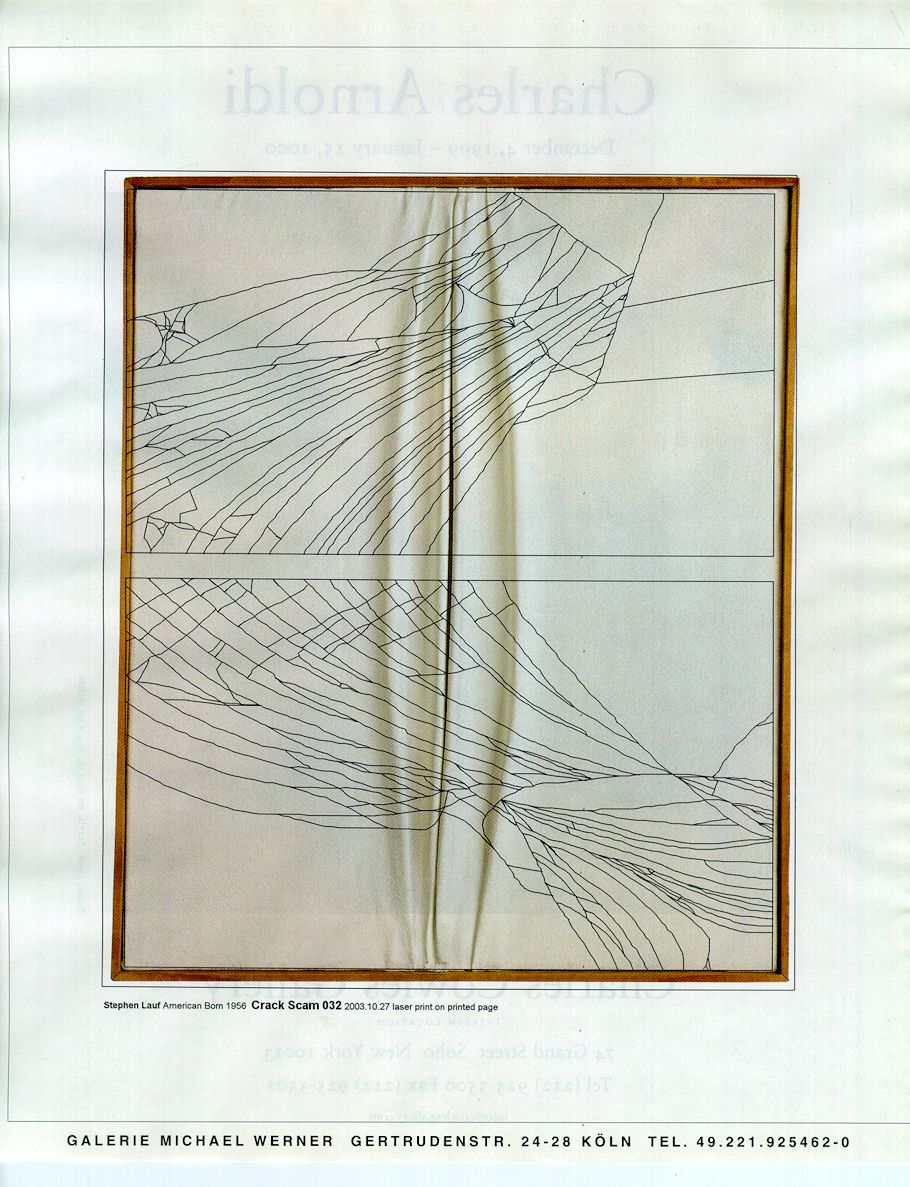
Crack Scam 032
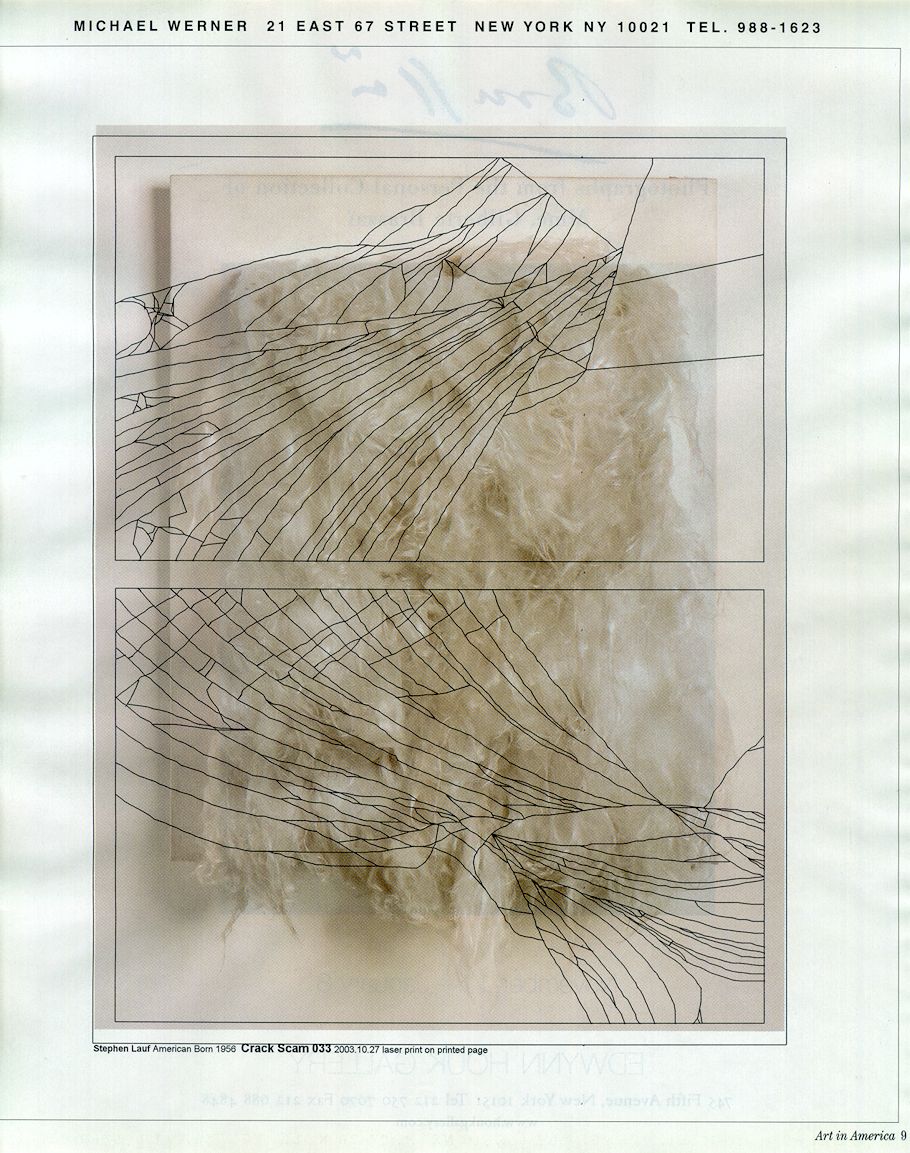
Crack Scam 033
27 October 2007
Collage Architecture
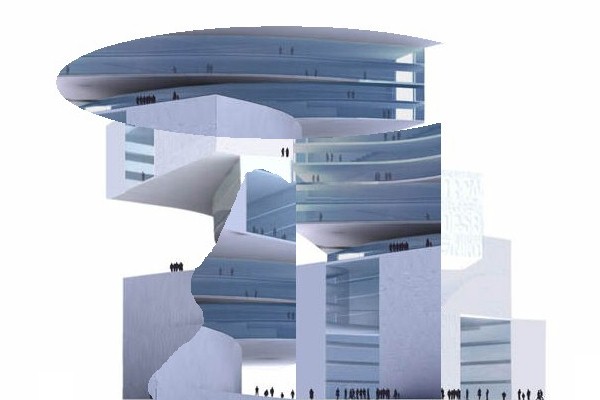
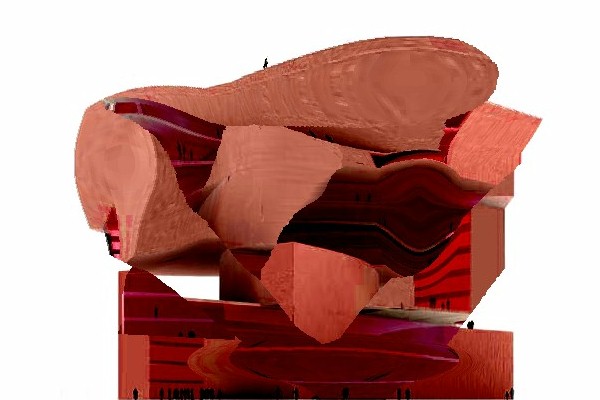

27 October 2017
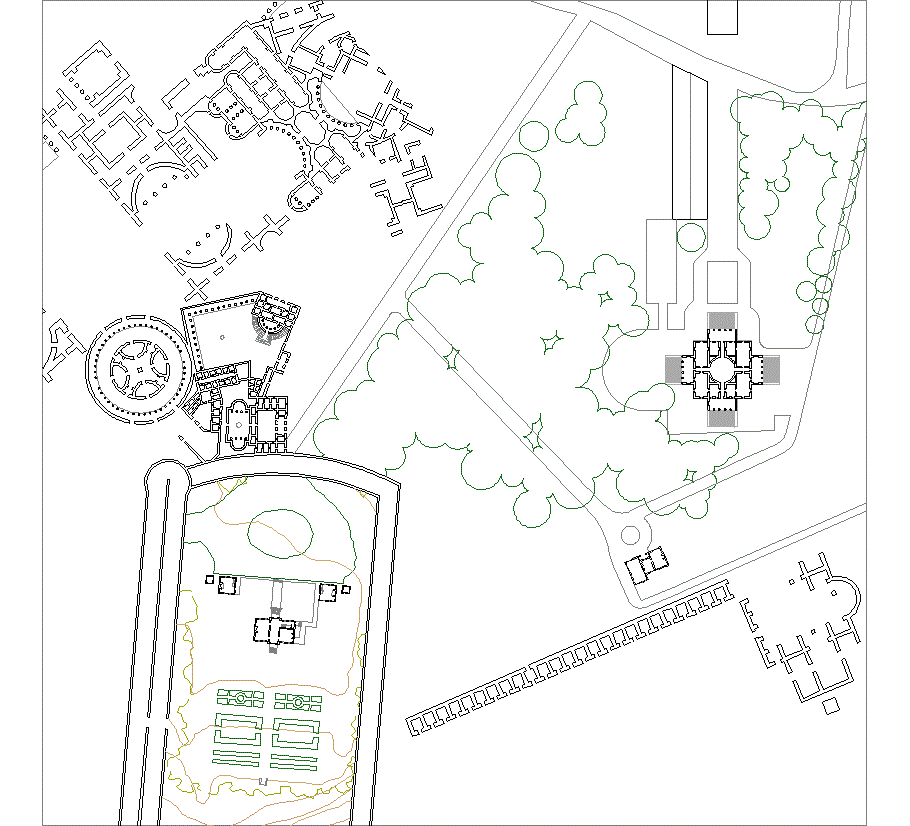
Hadrian's Villa Villa Rotonda Ury House Mount Pleasant plans
27 October 2009
Really, what boundaries have you pushed?
The first time I went to Chicago I took my bike, but I didn't take any map.
It was late summer 1978, and going from Perry, MO to Chicago for the weekend. Sunday morning left the downtown hotel and biked down to IIT and then to the Robie House and then over to the Lake Shore and then biked all the way along the Lake up to Oak Street Beach and took a dip in the Lake and then it was time to drive back to Missouri. Saw twin rainbows in the Illinois sky on the way 'home'.
Really, what boundaries have you pushed?
Just went to one of the local branches of the Free Library, a 1960 building very much inspired by the buildings of IIT (I'll have to take pictures some day).
27 October 2022 Thursday
Sent my mail-in ballot in the evening; the mailbox is across the street from where Ury used to be. The back of Ury had an enormous view of the north-to-east night sky, in part almost down to the horizon.
Was the circus of Maxentius so difficult to identify because all naming inscriptions were not damnatio memoriae-ed, but actually fully removed, under Eutropia's orders, as one of the first "architectural" tasks of Rome's new Constantinian regime? And, if so, might some, or even most, of the inscriptions still exist within the structure of the Arch of Constantine (and perhaps also in the Arch of Janus Quadrifrons)? Yes, a most imaginative speculation.
Eutropia's and Helena's "architectural" career begins in a few days from now, but plans were already being discussed the first nights they "camped" at the Castra Equitium Singularium.
27 October 2023 Friday
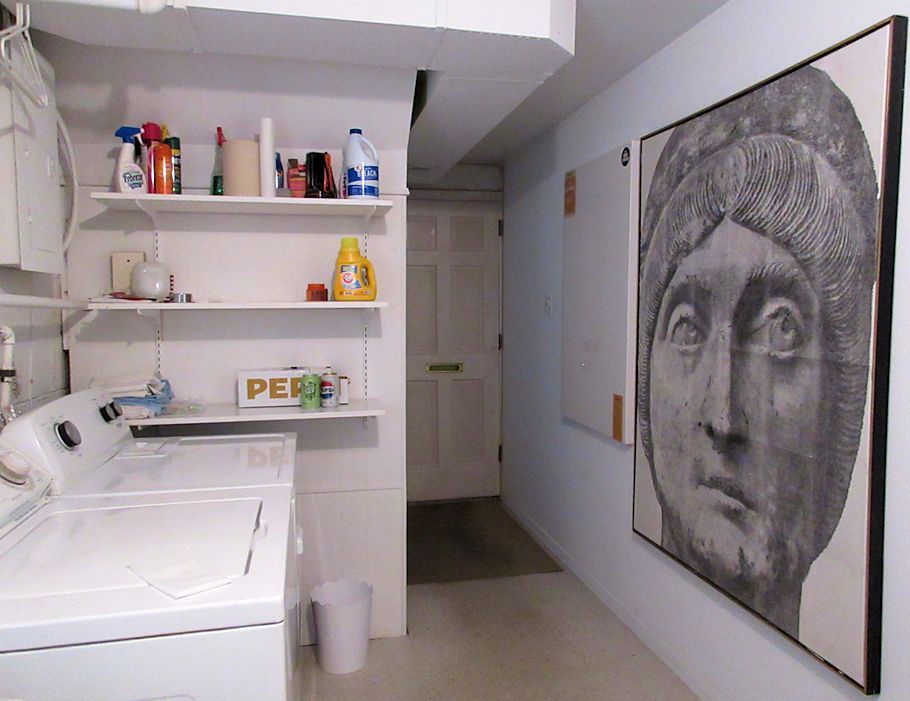
[Dropping the So-Called] Heilige Helena in the laundry room.
I started the work in the living room, and tonight it's entitled This one's for George. It, indeed, is being done for George--it will become one of the things he first sees in the morning, and among the last things he'll see at night. It might be done by 9 November (mostly?). Along with who knows what else, it will contain some pages of George's post-stroke writings. This one's for George is the second dedication of The Discovery of Piranesi's Final Project.
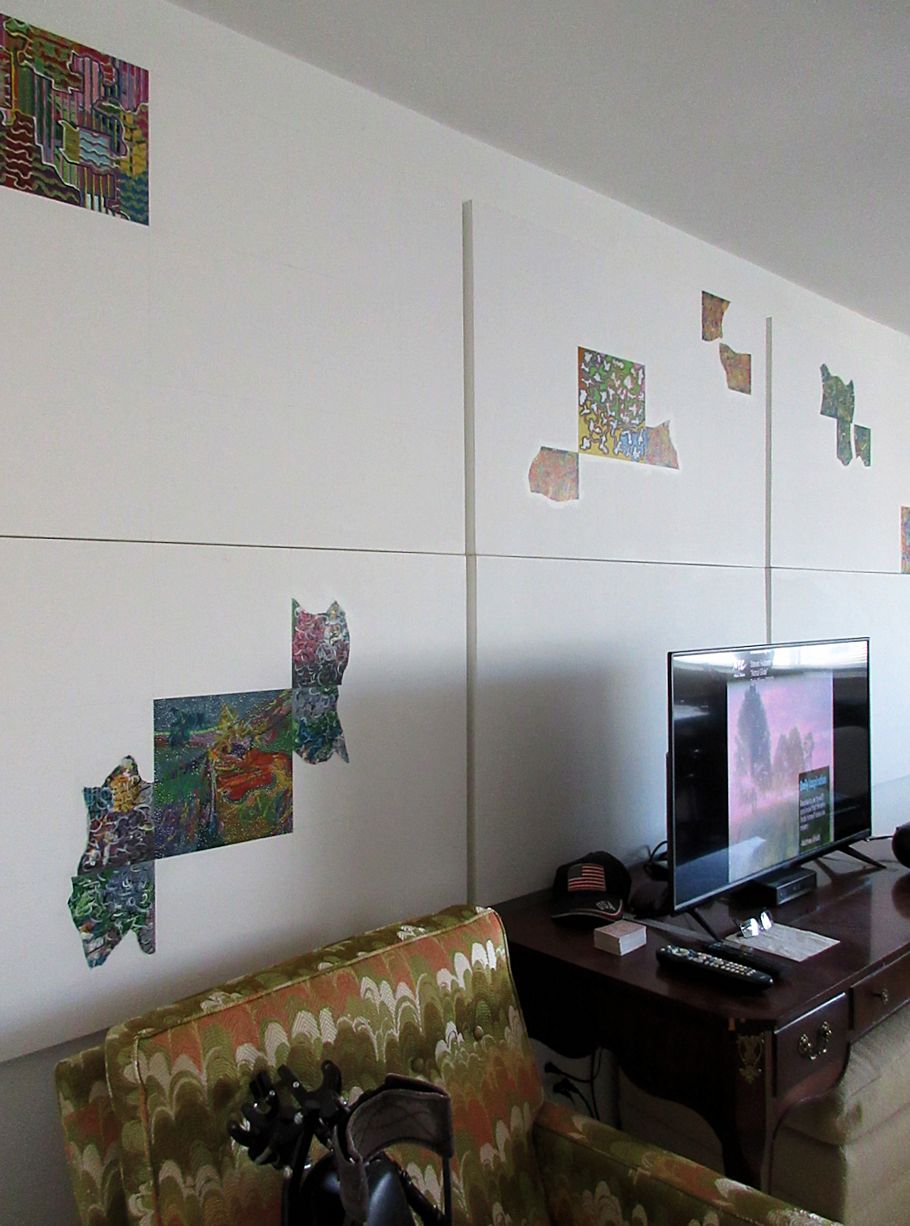
This one's for George work in progress
As great a project as The Discovery of Piranesi's Final Project has been, working on it, nonetheless, did impede my working on art. Now, however, the impediment no longer exists, and cathartic exuberance fully replaced it.
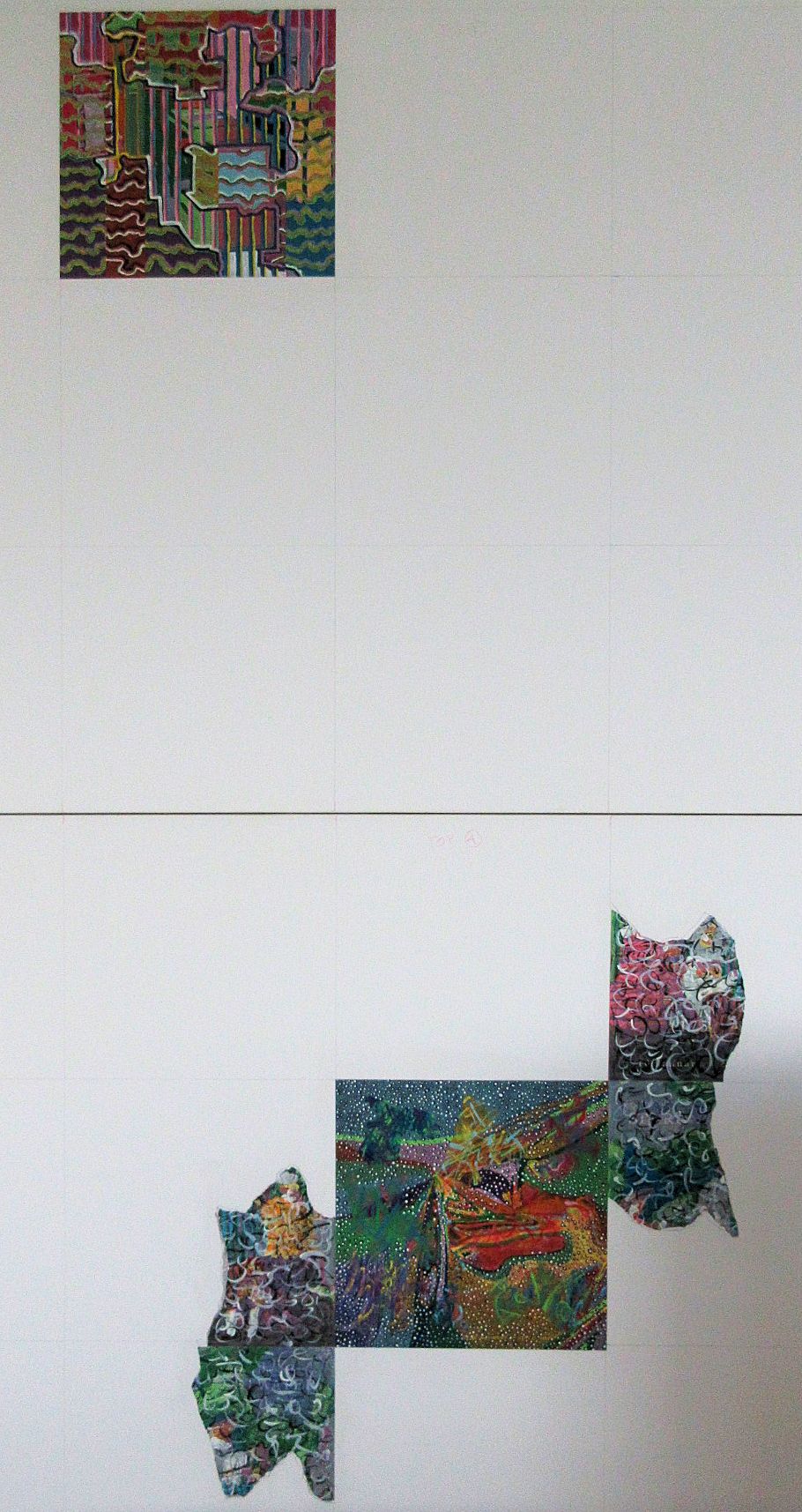
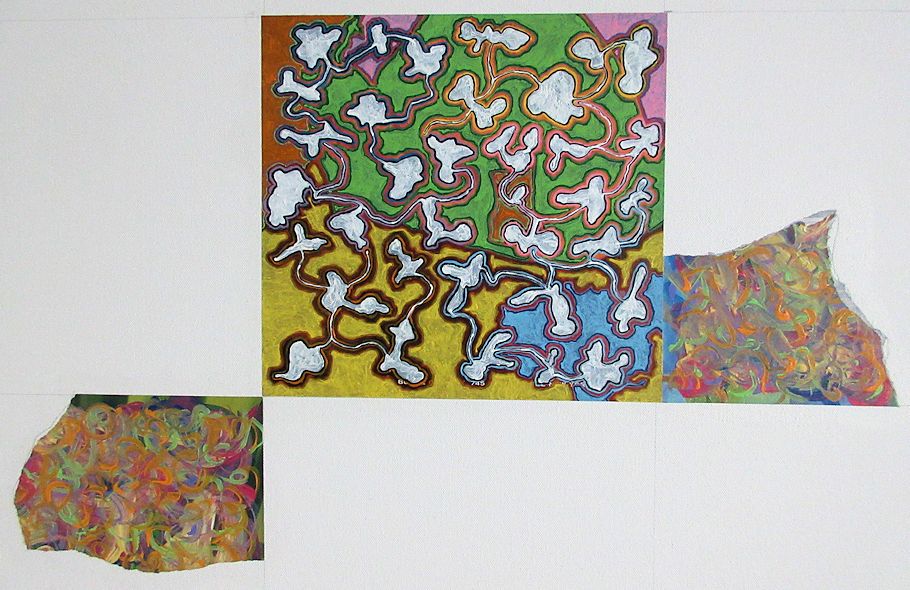
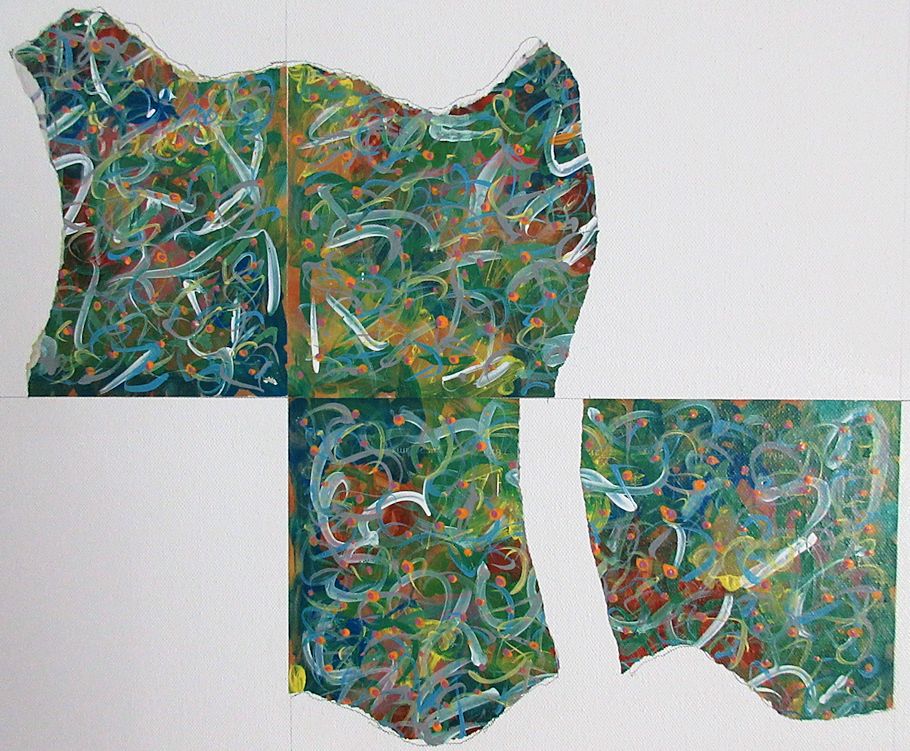
|